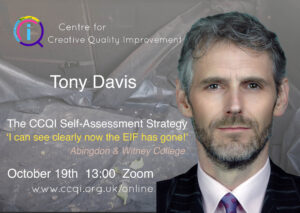Can cleaning your car boot help with self assessment?

I know, sounds a bit like clickbait, but hopefully you’ll feel this short read is worth it. Can cleaning your car boot really help you make judgements in your self-assessment report?
Over the last few weeks, I’ve really enjoyed working with a college on their self-assessment report. The main job was helping the lead author understand any issues with the text, where they were masking problems, rather than celebrating the discovery of issues, and helping them understand the difference between an SAR that will anchor them at ‘good’ and one that propels them to ‘outstanding’.
Once they’ve the writing, then comes the tricky question: how do you make the overall judgements? (We’ll be looking at all this in detail, by the way, on October 19th. More details here: www.ccqi.org.uk/SAR.)
At this point, I launched into my work on developing and using Quality Standards, which I’ll mention in a moment, but I found a much simpler way of describing the process the other day when cleaning my car boot.
Here’s the Quality Standard stuff first. ‘Quality’ only happens when you care. So the trick is to get your staff to care. In other words, if staff view the quality team as the quality police, then we have an us-and-them situation that’s good for no one. Every member of the team should value wearing the quality manager badge. This is so well understood that it’s almost a cliché. But how do you achieve it?
Well first on the list is the removal of Ofsted as the quality driver. While ever you use their inspection framework as your standard, staff will feel they’re having to march to someone else’s beat. The implications of this are huge. Are you ahead of me? Your front-line staff have to be the authors of your Quality Standard – the standard by which you all judge yourselves.
At this point, I need to add a side note on what I mean by a Quality Standard. Some quality auditors can find this a challenge. What it’s not is a ‘procedure that must be followed’; you know what I mean? You must do this, then that, then the other for a curriculum plan/lesson/progress review to be judged good. This is just ‘stuff’, and the number-1 rule about Quality Standard writing is that you’re not allowed to write any actions; any ‘stuff’.
A Quality Standard, then, is simply a set of statements the show how you intend learners to be different. If you want to do this properly, you’ll have a QS for every step of the learner’s journey: Recruitment, the Extended Induction Period, Teaching, assessment & learning, Progress Reviews, Support, Achievement, and Progression. The tricky bit is that they have to set out what ‘outstanding’ difference looks like in an unashamedly-idealistic environment. In other words, you can’t dumb it down because of budgets or ‘the type of students we have’ get-out clauses…
Only once you know what outstanding difference looks like can you design the curriculum plan, induction experiences, learning experiences, support strategies, etc, etc, you’ll need to have a chance of achieving it. Self assessment then become easy. You just have to ask two questions. The first and most important is ‘Are we getting there?’ By looking at your impact as soon as you can into a journey, you give yourself time to change your stuff if it’s not producing the difference you want. The second question is ‘Did we get there?’ The extent to which you did or not is your overall judgement. Your judgement calibrates the level of difference you made, not the amount of hard work you put in.
And then I cleaned my car. The boot was particularly messy with grass and mud. I instantly knew what an ‘outstandingly’ clean boot would look like: no mud or boots – as new. I knew that a ‘good’ job would mean that most of the mess would have gone, however, there’d still be those annoying bits of grass that weave their way into the carpet, and maybe some grit deep down…
So I knew the difference I wanted to make. I knew what I needed to do to achieve it. And once done, I evaluated the extent to which I’d achieved my outcome. That’s self assessment in a nutshell, using a car-boot Quality Standard.
We’re spending an afternoon looking at a detailed system for this on October 19th, via Zoom. We’ll look at the two separate processes of self assessment and development planning in a way that may well surprise. You can find more details here: www.ccqi.org.uk/SAR. Do please join us if you can and tag any of your colleagues who might be interested, and/or share with your own networks if you’re able. Here are some of my favourite comments that represent the impact this session might have on your team:
- ‘I can see clearly now the EIF has gone!’ Abingdon & Witney College
- ‘Big conversation captured on a simple form.’ Bury College
- ‘It felt like I was given the key to the secret world of writing SARs!’ Leicestershire Adult Learning Service
- ‘Can’t be more impressed! Changing a long, dull, time-consuming, & painful process into a learning journey broken down into several steps & stages with simple yet effective tools & resources.’ OxfordSaudia Flight Academy




Comments
No comments yet